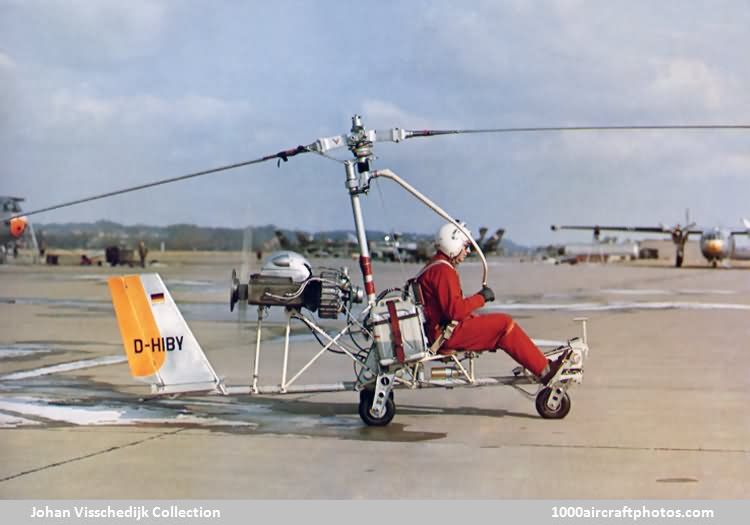02/28/2014. Remarks by Johan Visschedijk: "In the early 1960s, the Weser Flugzeugbau GmbH (also known as Weserflug) of Bremen, Germany, was working on several rotary wing projects, one of these was to develop a relatively inexpensive simplified rotary wing craft, but without gearbox, tail rotor, lubrication system and collective pitch lever.
Additional test objectives were: Reduction of instability effects during hovering flight; investigation into certain advantages of the heavy rotor; substantial damping of structural oscillation and vibration. The first step in this project was the design of a single-seat flying test vehicle, designated WFG H 2, which had a configuration basically similar to that of the well-known Bensen Gyro-Copter.
In November 1963, Weser merged with the Focke-Wulf GmbH, also of Bremen, and the new company was named Vereingte Flugtechnische Werke (VFW), and in 1964 the Ernst Heinkel GmbH of Speyer, also joined in. Then known as the VFW WFG H 2 (later VFW H 2), the test vehicle was flown for the first time at Lemwerder, near Bremen, on April 30, 1965.
To provide hovering capability, this aircraft had a fully-articulated two-blade rotor with tiny blade-tip burners. Each blade was carried on a single Teflon bearing, which would normally provide drag, flap and pitch-change freedom; but the drag hinge was locked on the two-blade rotor of this test bed aircraft. Cyclic control was achieved by tilting the rotor head, using an overhead stick; but the usual collective-pitch control was replaced by a rpm-governor controlled via the throttle lever.
Power plant was a 72 hp McCulloch four-cylinder horizontally-opposed air-cooled two-stroke engine, driving both the Hoffman two-blade fixed-pitch pusher propeller and a small centrifugal compressor. Air from the compressor could be ejected 'cold' and 'hot' from the blade-tip burners for rotor spin-up prior to a jump take off. However, in the first test phase of 25 flying hours, during which the photos above were taken, air ejection was not utilized. In later flights, as shown by the presence of a duct between compressor and rotor in this photo, air ejection was utilized.
For true vertical take off or hovering, the air was mixed with fuel and burned in the blade-tip nozzles, the fuel being the same as that used by the McCulloch engine. A rotor speed of up to 780 rpm had been attained during ground running; speeds of about 630 rpm was required for hovering and only 550 rpm for autorotation, thus giving an extremely wide and safe rotor speed range. Change over to autorotation was not required. The aircraft had an excellent maneuverability on the ground, also with non-rotating rotor.
The flight test results were very positive and the already projected WFG H 3 was built as the VFW H 3 Sprinter. The H 2 was stricken from the register in 1971 and is preserved at the Hubschraubermuseum at Bückeburg."
